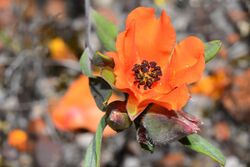Hibbertia miniata
Topic: Biology
 From HandWiki - Reading time: 2 min
From HandWiki - Reading time: 2 min
| Orange flower | |
|---|---|

| |
| Scientific classification | |
| Kingdom: | Plantae |
| Clade: | Tracheophytes |
| Clade: | Angiosperms |
| Clade: | Eudicots |
| Order: | Dilleniales |
| Family: | Dilleniaceae |
| Genus: | Hibbertia |
| Species: | H. miniata
|
| Binomial name | |
| Hibbertia miniata C.A.Gardner[1]
| |
Hibbertia miniata, commonly known as orange flower,[2] is a small shrub in the family Dilleniaceae and is endemic to Western Australia.
Description
Hibbertia miniata is either an erect small shrub or grows horizontally along the ground and 0.1–1 m (3.9 in–3 ft 3.4 in) high and rounded in outline. The leaves are lance-shaped, broader and rounded at the apex, sessile, 3–3.5 cm (1.2–1.4 in) long, 4–7 mm (0.16–0.28 in) wide, densely covered with grey short, soft, matted hairs or soft, silky hairs. The leaf edges rolled under, becoming more pronounced as they dry. The mid-rib on the underside prominent. The dry flower bracts are broad, brown, egg-shaped to lance egg-shaped, concave, smooth and acute at the apex. The peduncles are smooth with very short silky hairs. The sepals are lance to egg-shaped, 1–1.2 cm (0.39–0.47 in) long, silky with white, soft, flattened hairs and sharply pointed. The large orange to reddish-orange flower petals are egg-shaped, deeply lobed, 2 cm (0.79 in) long and 1.5 cm (0.59 in) wide. The flowers are borne singly or in small groups at the end of the branches on a short stalk. Flowering occurs from August to November.[2][3]
Taxonomy and naming
Hibbertia miniata was first formally described in 1936 by Charles Austin Gardner and the description was published in Journal of the Royal Society of Western Australia.[3][4] The species name (miniata) is a Latin word meaning "flame-scarlet".[5]
Distribution and habitat
Orange flower hibbertia has a restricted distribution, grows in gravelly lateritic soils in Chittering, Gingin, Moora, Toodyay and Victoria Plains.
References
- ↑ "Hibbertia miniata". https://biodiversity.org.au/nsl/services/apc-format/display/71283. Retrieved 31 December 2019.
- ↑ 2.0 2.1 "Hibbertia miniata". FloraBase. Western Australian Government Department of Parks and Wildlife. https://florabase.dpaw.wa.gov.au/browse/profile/5145.
- ↑ 3.0 3.1 Gardner, G.A. (1936). "Hibbertia miniata". Journal of the Royal Society of Western Australia 22: 124. https://www.biodiversitylibrary.org/item/187446#page/176/mode/1up. Retrieved 2 January 2020.
- ↑ "Hibbertia miniata". https://biodiversity.org.au/nsl/services/rest/instance/apni/482378. Retrieved 2 January 2020.
- ↑ Sharr, Francis Aubie (2019). Western Australian Plant Names & their meanings. Kardinya Western Australia: Four Gables Press. p. 253. ISBN 9780958034180.
Wikidata ☰ Q17395304 entry
 |
 KSF
KSF